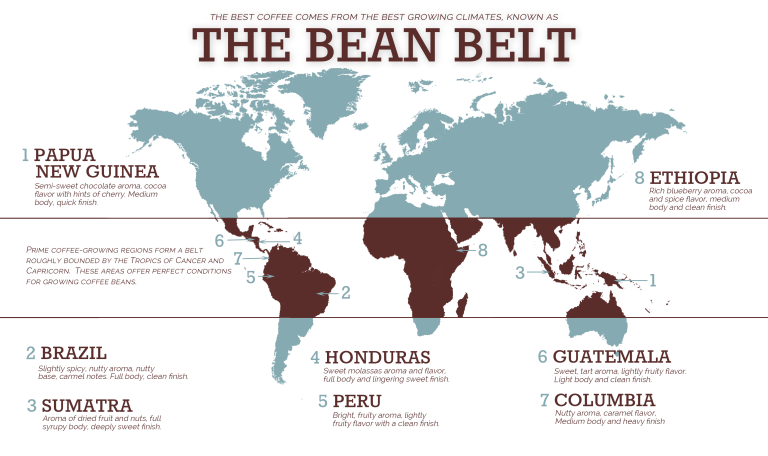Ever wondered where is coffee grown that creates your morning brew? The coffee bean belt circles our planet like a green gem necklace, nestled between the Tropics of Cancer and Capricorn. This narrow band offers perfect growing conditions for coffee trees that demand specific climate, soil, and elevation.
Not just beautiful, this region is crucial to global economics. Coffee farms in these regions produce over 10.5 million tons each year. This makes coffee the world’s second most traded product after oil. This vital agricultural zone supports 25 million farmers across more than 50 countries.
But now, this delicate balance faces a serious threat. Climate change rapidly changes growing conditions. This could reshape where coffee grows worldwide and alter the flavors we’ve enjoyed for centuries.
What is the Coffee Bean Belt and Where is Coffee Grown?
The bean belt forms a narrow band around Earth between the Tropic of Cancer (23.5°N) and the Tropic of Capricorn (23.5°S). This zone sits roughly 30 degrees north and south of the equator.
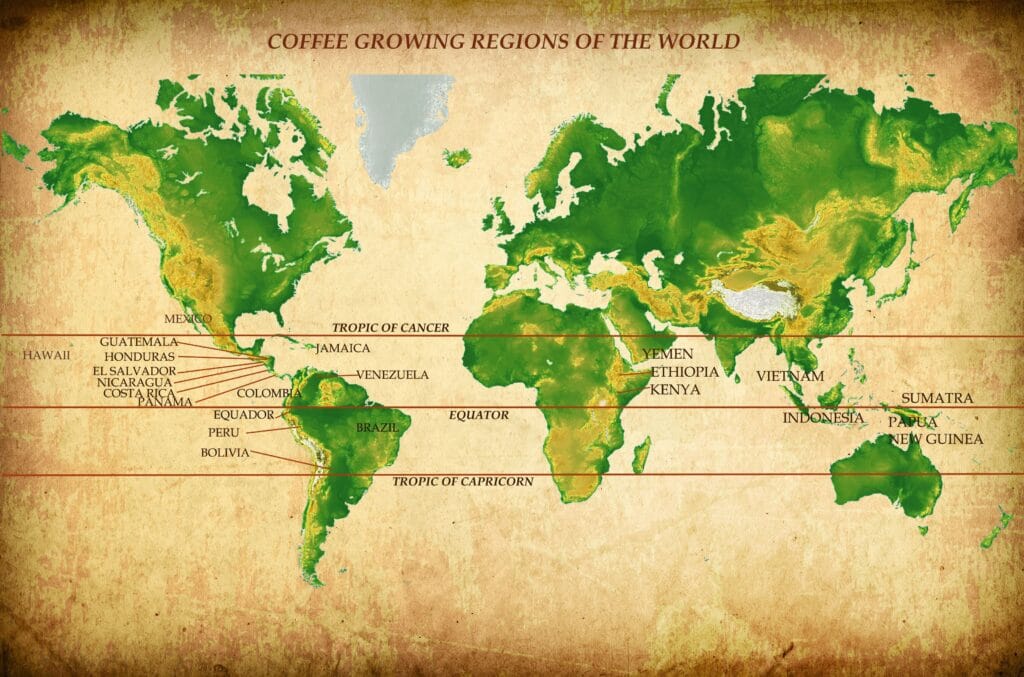
Any coffee belt map shows all major coffee regions within this strip across Latin America, Africa, and Asia. But where is coffee grown exactly? The answer includes countries like Brazil, Colombia, Ethiopia, Vietnam, and Indonesia, where unique local conditions create distinct coffee flavors.
According to the International Coffee Organization, coffee trees evolved as understory plants in African forests. They adapted to thrive in stable temperatures between 60-70°F, moderate rainfall patterns, and rich soils with good drainage. The bean belt provides these perfect Goldilocks conditions year-round.
Coffee plants struggle outside these latitudes because they can’t tolerate frost or extreme heat. Studies by World Coffee Research show that coffee needs very specific temperatures. This explains why coffee grows mainly in this band, making it a global crop with unique regional flavors.
Perfect Climate and Growing Conditions
Successful coffee growing depends on a precise mix of natural elements. The ideal climate features steady temperatures between 60-70°F (15-24°C) with annual rainfall of 60-90 inches (1,500-2,200mm). Coffee trees need this rain spread across clear wet and dry seasons to trigger proper flowering and fruit development.
Elevation plays a crucial role too. The best Arabica coffees come from high altitude farms at 3,000-6,500 feet (900-2,000m). At these heights, cool nights slow bean growth, allowing complex flavors to develop.
Research on Ethiopian Arabica coffee indicates that increased altitude leads to:
- Decreased caffeine and chlorogenic acid content
- Significant increases in sucrose, acidity, and flavor
The foundation of great coffee is rich soil with excellent drainage. Volcanic soils rich in minerals and organic matter provide ideal growing conditions. Many top coffee regions sit on ancient volcanic slopes where nutrient-dense soil feeds the trees. Climate change now directly threatens these ideal growing conditions: steady temperatures, seasonal rains, high mountains, and rich soil.
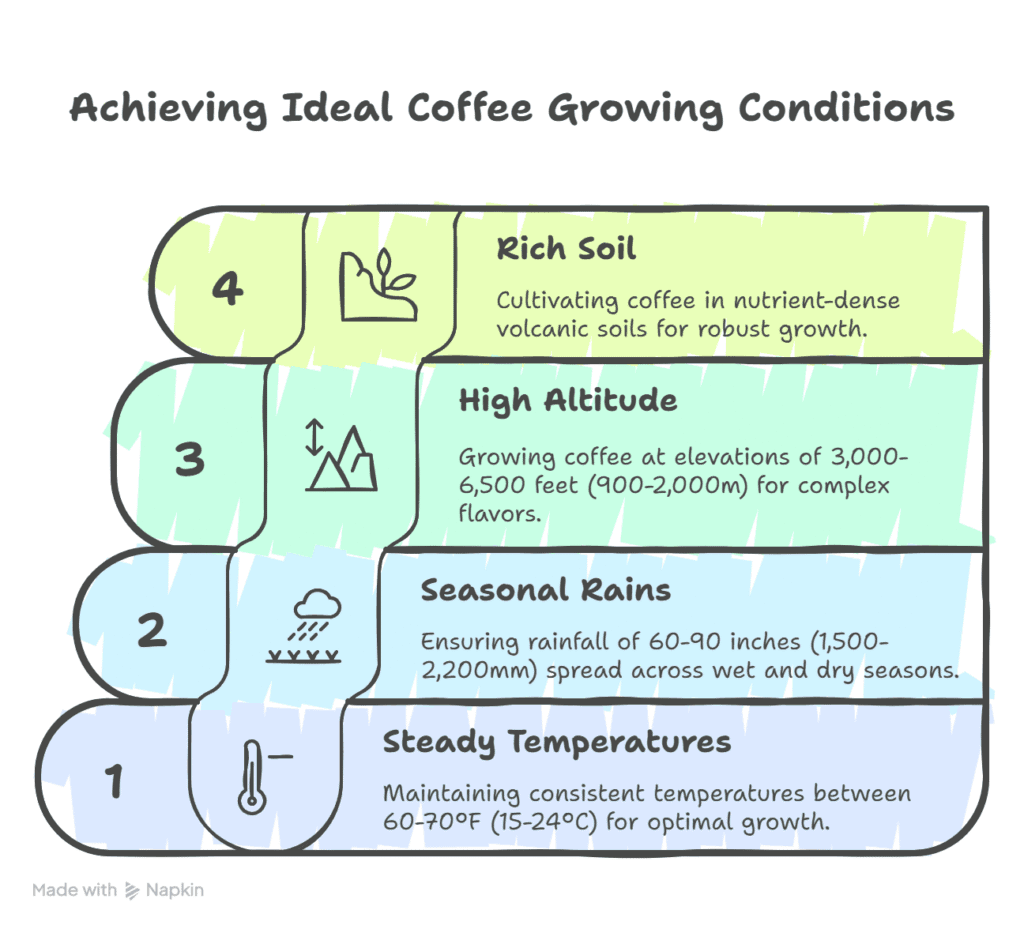
Major Coffee Growing Regions in the Bean Belt
Coffee growing regions in the Bean Belt split into three main areas. Each has unique features shaped by local land and weather patterns. Let’s explore these regions and their major producers:
Brazil is the world’s top coffee maker. In 2023, Brazil grew 3.8 million tons of coffee. This country produces about one-third of all coffee in the world.
Brazilian farms feature vast mechanized operations on rolling terrain. Colombia, the third-largest producer globally (754,000 tons), contrasts with steep mountainous farms where hand-picking ensures quality. These coffee growing countries benefit from ideal altitude variations and well-defined rainy seasons.
Africa’s coffee comes mainly from Ethiopia (coffee’s birthplace), which grows 482,000 tons yearly. Kenya and Uganda also produce large amounts. African coffee regions typically feature smallholder farms at high elevations with ancient varieties unknown elsewhere. These regions face some of the most severe climate threats due to increased drought frequency.
In Asia, Vietnam ranks second worldwide with 1.8 million tons, mostly Robusta coffee. Indonesia produces 658,000 tons using unique processing methods. Southeast Asia’s coffee sector has expanded rapidly in recent decades, with unique monsoon patterns influencing growing cycles. These countries often grow coffee with other plants in mixed farming systems that might help withstand climate changes.
Each growing area faces its own climate problems. In Latin America, highland farms deal with random rains. In Africa, farms struggle with long dry spells. Asian coffee farms must handle more extreme weather events.
Regional Flavor Profiles and Characteristics
The flavor in your cup directly reflects where those coffee beans grew:
South America coffees, particularly Brazilian varieties, offer nutty, chocolate notes with medium acidity and body. Colombian arabica coffee presents bright citrus acidity with caramel sweetness. Q-grader Maria Ruiz says, “Colombia’s volcanic soils and mild temperatures create the right mix of acidity and sweetness. This is what makes these beans famous worldwide.”
African coffees stand out with vibrant complexity. Ethiopian beans showcase distinctive floral notes, berry fruitiness, and wine-like qualities. Kenyan coffees deliver bold blackcurrant flavors with sparkling acidity. “Strong sun, cool nights, and high mountains stress coffee plants just enough to create amazing complex flavors,” says coffee expert James Hoffmann.
Asian coffees, particularly Indonesian varieties, tend toward full-bodied cups with earthy, spicy, and sometimes herbaceous qualities. Vietnam’s Robusta beans provide deep, bold flavors with higher caffeine content.
These regional characteristics link directly to local growing conditions. Rising temperatures force farms to move higher up mountains, threatening these unique flavors.
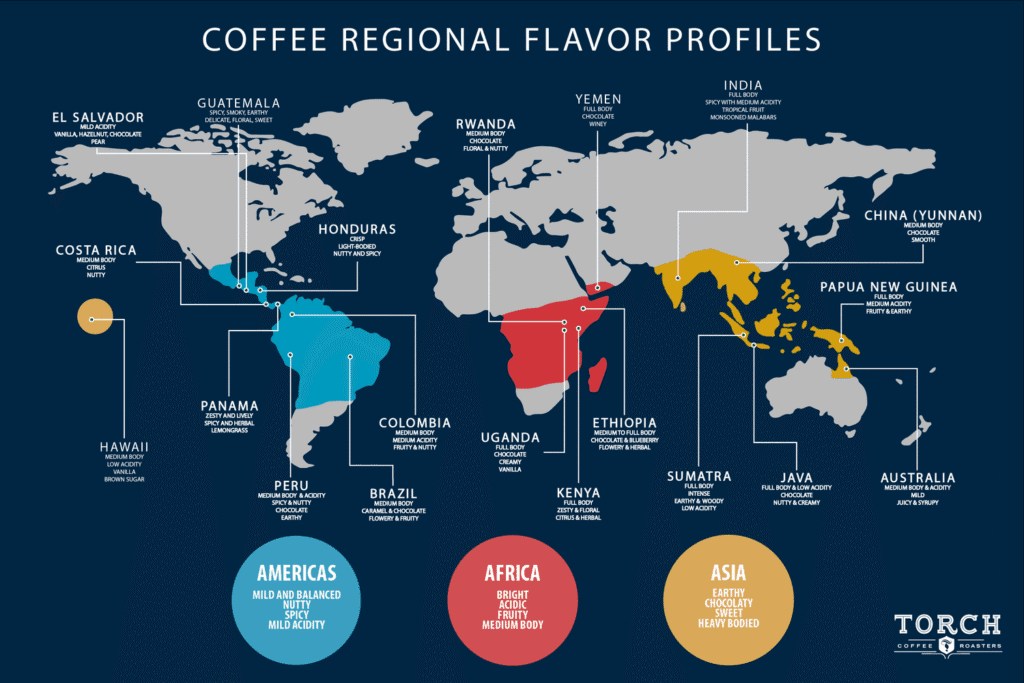
Climate Change and the Future of the Coffee Bean Belt
The coffee belt faces an unprecedented crisis. Recent data shows worrying trends: higher temperatures, changing rain patterns, and more pests now disrupt coffee farms worldwide. The key “Climate Change and Coffee Production” study (2023) warns that by 2050, good coffee-growing land might shrink by half.
For each 1°C rise, flowering patterns change and yields drop by approximately 15%. Rainfall disruptions further complicate coffee production, with both droughts and flooding becoming more common. The most vulnerable areas include:
- Low-elevation regions in Brazil, where temperature increases already exceed global averages
- Ethiopian highlands, where rainfall patterns have become increasingly unpredictable
- Central America countries like Honduras and Guatemala, facing more frequent extreme weather events
- Southeast Asian regions battling new pest and disease outbreaks due to warming trends
“Farmers are moving their coffee plants uphill to find cooler weather,” says Dr. Aaron Davis who works at Royal Botanic Gardens. This upward shift has limits—mountains have finite height, and suitable soils may not exist at higher elevations.
Climate change now endangers over 60% of wild coffee species. This may limit how we can adapt coffee through breeding programs.
We need quick action now. Without it, the coffee belt will shrink and shift. This will change the global coffee industry. It will also put millions of coffee-related jobs at risk.
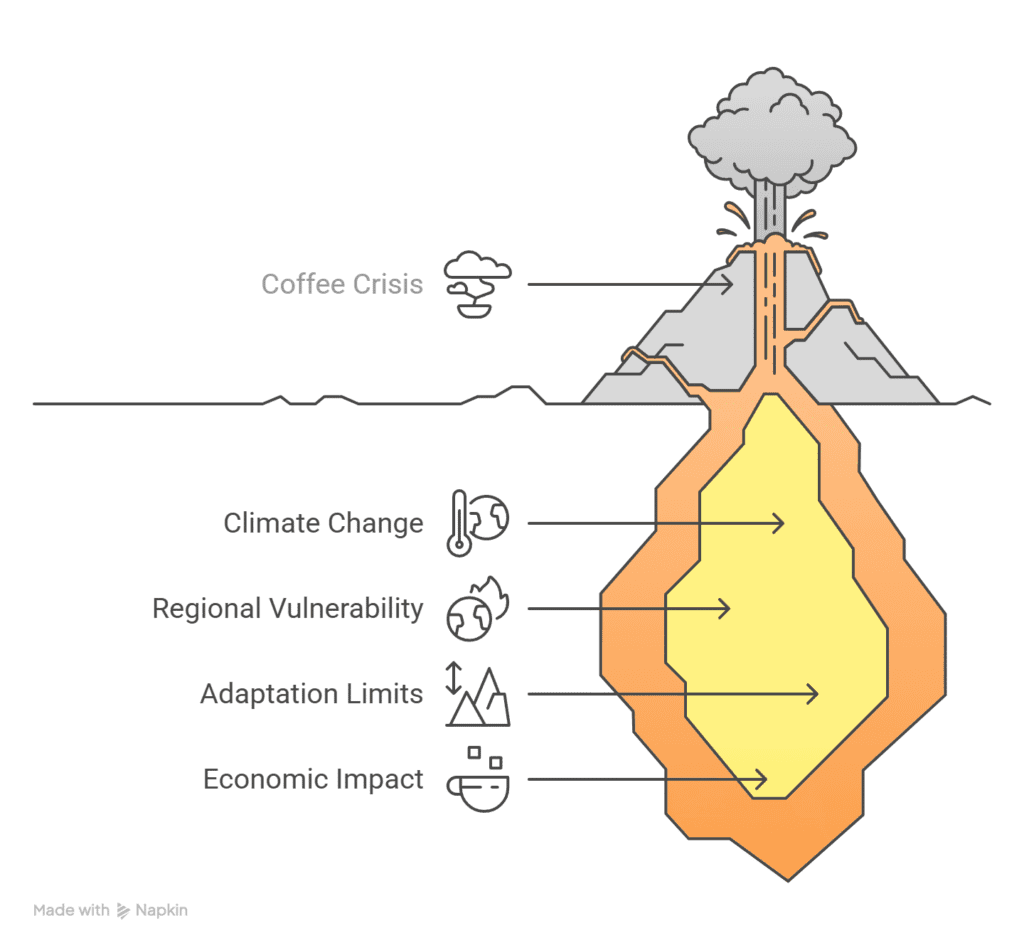
Adaptation Strategies and New Growing Frontiers
Coffee farmers aren’t waiting for disaster—they’re acting now to secure the future of coffee production. Several promising adaptation strategies have emerged:
Shade-grown coffee cultivation is gaining popularity. By planting trees alongside coffee, farmers create microclimates that moderate temperature extremes and protect crops from erratic weather. The World Coffee Research organization’s “Resilient Coffee” project has documented temperature reductions of 2-4°C under shade systems.
Breeding programs are developing heat and drought-tolerant varieties. “We’re finding coffee types that stay tasty even in heat and with less water,” explains Dr. Christophe Montagnon of World Coffee Research.
New high altitude frontiers are opening in unexpected places. Countries like China (Yunnan province), northern Thailand, and even California are experimenting with coffee growing zones previously considered unsuitable. Meanwhile, traditional producers are exploring higher elevations—some Colombian farms now grow coffee above 2,200 meters.
Technological solutions include precision irrigation, climate monitoring systems, and improved processing methods that require less water. These innovations help farmers maximize resources and reduce weakness.
The most promising approach combines these strategies into integrated systems. As climate zones shift, coffee’s future depends on both preserving traditional knowledge and embracing innovation. Coffee lovers who support eco-friendly farming today help make sure their favorite beans will still grow well in the future.
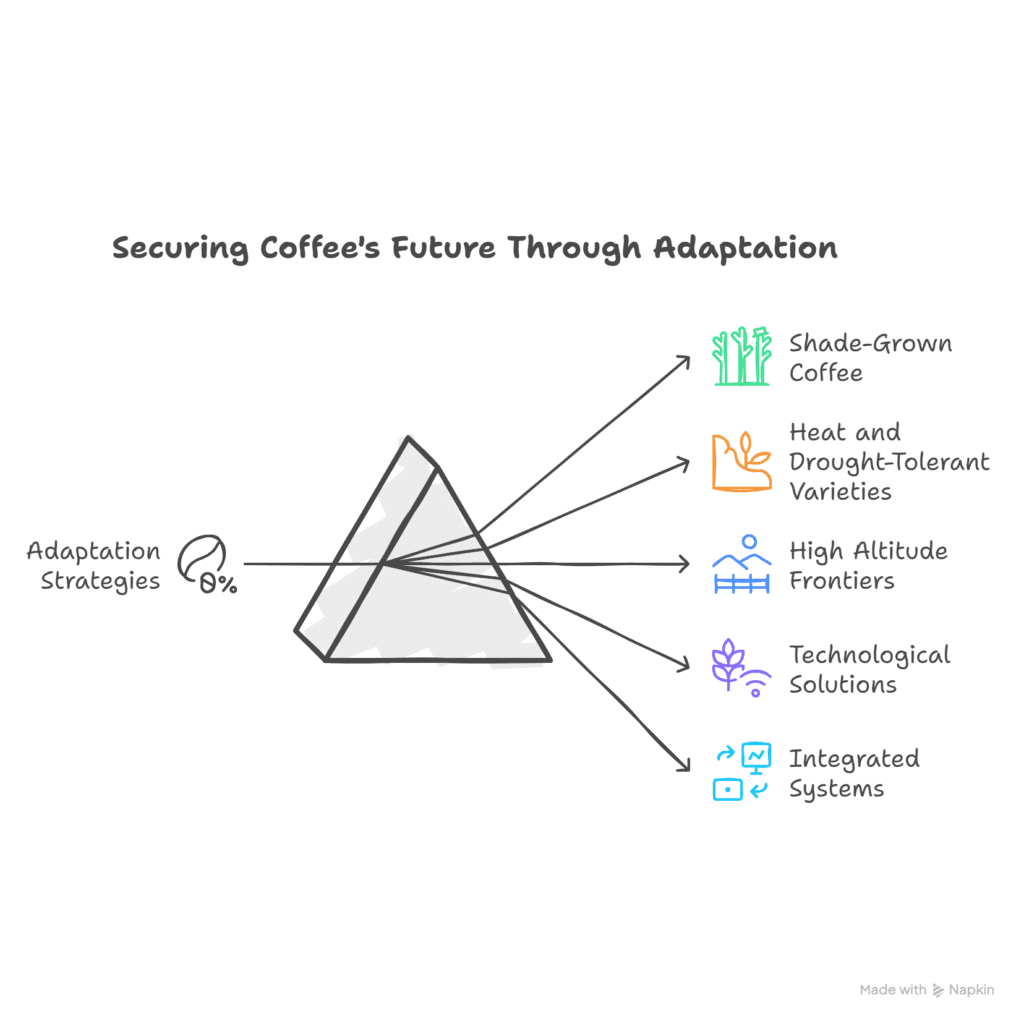
Conclusion
The coffee bean belt stands at a critical crossroads. This narrow band that circles our planet has given us centuries of remarkable flavors and supported millions of livelihoods. But the changing climate threatens to redraw these coffee growing regions significantly.
When we support smart farming and buy eco-friendly coffee, we help ensure that future generations can enjoy the many types of coffee. The challenges are real, but so are the solutions—the time to act is now.

